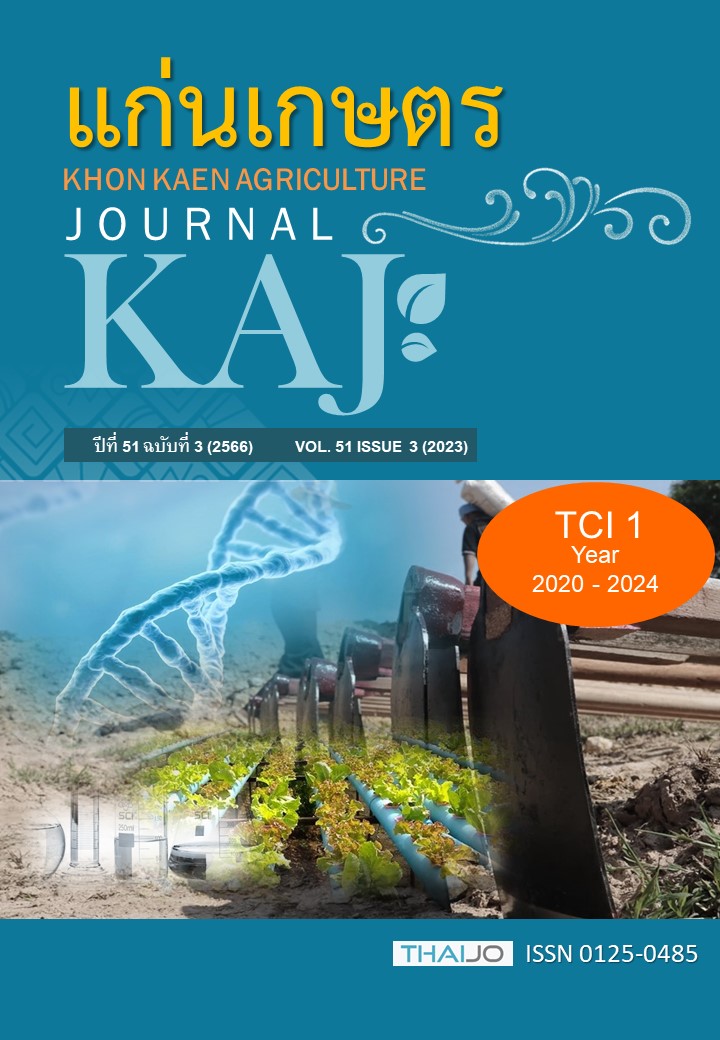อิทธิพลของสารบราสสิโนสเตียรอยด์ต่อการเพิ่มความทนอุณหภูมิสูงในข้าว
Main Article Content
บทคัดย่อ
สภาพอากาศที่เปลี่ยนแปลงเนื่องจากสภาวะโลกร้อนส่งผลให้อุณหภูมิของโลกสูงขึ้น ส่งผลต่อการผลิตข้าวในฤดูนาปรังในแถบภาคตะวันออกเฉียงเหนือของประเทศไทย โดยอุณหภูมิที่เพิ่มสูงขึ้นมากกว่า 40 oC จะทำให้ข้าวเป็นหมัน ผลผลิตของข้าวลดลง และส่งผลต่อการลดลงของอัตราการสังเคราะห์ด้วยแสงสุทธิ ทั้งยังทำให้เยื่อหุ้มภายในเซลล์และรงควัตถุที่ใช้ในการสังเคราะห์ด้วยแสงถูกทำลาย ดังนั้นจึงมีการศึกษาการใช้สารบราสสิโนสเตียรอยด์ (Br) ซึ่งเป็นสารควบคุมการเจริญเติบโตของพืชในกลุ่มสเตียรอยด์ ในข้าวที่ปลูกในสภาพเรือนทดลอง ใช้แผนการทดลอง completely randomized design (CRD) จำนวน 4 ซ้ำ ตั้งแต่เดือนมกราคม-มิถุนายน 2564 โดยใช้ข้าวพันธุ์ N22 ที่ระยะดอกบาน 50% ทำการพ่นสารบราสสิโนสเตียรอยด์ ที่ระดับความเข้มข้นดังนี้คือ 0 (น้ำเปล่า; DW), 0.05, 0.1 และ 0.5 nM มีการให้อุณหภูมิสูงในเวลากลางวัน/กลางคืน (42/32 ºC) เป็นเวลา 7 วัน (H) และให้อุณหภูมิปกติในสภาพเรือนทดลอง (UH) จากการศึกษาพบว่า การให้ Br มีผลช่วยให้ข้าวเพิ่มความต้านทานต่อความร้อนโดยมีอัตราการสังเคราะห์ด้วยแสงสุทธิ และปริมาณคลอโรฟิลล์เพิ่มขึ้น และรักษาความเสถียรภาพของเยื่อหุ้ม แสดงให้เห็นว่าสาร Br อาจส่งเสริมการทำงานของเอนไซม์ต้านอนุมูลอิสระเพื่อกำจัดสารอนุมูลอิสระจึงรักษาสภาพของเยื่อหุ้มไทลาคอยด์และเยื่อหุ้มเซลล์ ส่งผลทำให้คลอโรฟิลล์ที่ฝังตัวในเยื่อหุ้มไทลาคอยด์ไม่ถูกทำลายและกระบวนการสังเคราะห์ด้วยแสงเพิ่มขึ้น และชักนำให้มีการสะสมอาหารในเมล็ดเพิ่มขึ้น ส่งผลทำให้ผลผลิตข้าวเพิ่มขึ้น และมีความทนต่อสภาพอุณหภูมิสูง
Article Details

อนุญาตภายใต้เงื่อนไข Creative Commons Attribution-NonCommercial-NoDerivatives 4.0 International License.
เอกสารอ้างอิง
ณัฐชยา ลิมโกมลวิลาศ, วีรศิลป์ สอนจรูญ, อรอุษา คาสุข และคณพล จุฑามณี. 2561. ผลของบราสสิโนสเตียรอยด์แอนาลอก ต่อการงอกละอองเรณูและการติดเมล็ดของข้าวพันธุ์ปทุมธานี1 ในระยะตั้งท้อง ภายใต้ภาวะเครียดจากความร้อน. วารสารเกษตรพระจอมเกล้า. 36: 124-131.
สุชาดา บุญเลิศนิรันดร์, ละอองศรี ศิริเกสร และกิตติ บุญเลิศนิรันดร. 2561. ผลของไคโตซานต่อผลผลิตของข้าวที่ได้รับอุณหภูมิสูงในช่วง ระยะการเจริญเติบโตต่าง ๆ กัน. วารสารเกษตรพระจอมเกล้า. 36(2): 73-84.
Arnon, D.I. 1949. Copper enzymes in isolated chloroplast polyphenoloxidase in Betavalgaris. Plant Physiology. 24:1–15.
Bajguz, A. 2019. Brassinosteroids in microalgae: application for growth improvement and protection against abiotic stresses, plant growth and development. Springer Nature Singapore. pp 45–58.
Bajracharya, D. 1999. Experiments in plant physiology: A laboratory manual. New Delhi, India: Norasa Publishing House.
Bajji, M., J.M. Kinet, and S. Lutts. 2002. The use of the electrolyte leakage method for assessing cell membrane stability as a water stress tolerance test in durum wheat. Plant Growth Regulation. 36: 61–70.
Chen, Y., H. Chen, J. Xiang, Y. Zhang, Z. Wang, D. Zhu, J. Wang, Y. Zhang, and Y. Wang. 2021. Rice spikelet formation inhibition caused by decreased sugar utilization under high temperature is associated with brassinolide decomposition. Environmental and Experimental Botany. 190: 1-12.
Dongsansuk, A., W. Paethaisong, and P. Theerakulpisut. 2021. Membrane stability and antioxidant enzyme activity of rice seedlings in response to short-term high temperature treatments. Chilean Journal of Agriculture Research. 81(4): 607-617.
Higashi, Y., and K. Saito. 2019. Lipidomic studies of membrane glycerolipids in plant leaves under heat stress. Progress in Lipid Research. 75: 1-15.
Jagadish, S.V.K., R. Mathurajan, R. Oane, T.R. Wheeler, S. Heuer, J. Bennett, and P.Q. Carufurd. 2010. Physiological and proteomic approaches to approaches to address heat tolerance during anthesis in rice (Oryza sativa L.). Journal of Experimental Botany. 61: 143-156.
Li, N., D. Euring, J.Y. Cha, Z. Lin, M. Lu, L. J. Huang, and W.Y. Kim. 2021. Plant hormone-mediated regulation of heat tolerance in response to global climate change. Frontiers in Plant Science. 11: 2318.
Poli, Y., R.K. Basava, M. Panigrahy, V.P. Vinukonda, N.R. Dokula, S.R. Voleti, S. Desiraju, and S. Neelamraju. 2013. Characterization of a Nagina22 rice mutant for heat tolerance and mapping of yield traits. Rice. 6: 36–42.
Prasertthai, P., W. Paethaisong, P. Theerakulpisut, and A. Dongsansuk. 2022. High temperature alters leaf lipid membrane composition associated with photochemistry of PSII and membrane thermostability in rice seedlings. Plants. 11(1454): 1-15.
Samakovli, D., T. Margaritopoulou, C. Prassinos, D. Milioni, and P. Hatzopoulos. 2014. Brassinosteroid nuclear signaling recruits HSP90 activity. New Phytologist. 203: 743–757.
Siddiqui, H., F. Sami, M. Faizan, A. Faraz, and S. Hayat. 2019. Brassinosteroid mediated regulation of photosynthesis in plants. In Brassinosteroids: Plant Growth and Development. Springer Nature Singapore. 185-217.
Siddiqui, H., S. Haya, and A. Bajguz. 2018. Regulation of photosynthesis by brassinosteroids in plants. Acta Physiologiae Plantarum. 40: 59.
Sonjaroon, W., K. Jutamanee, O. Khamsuk, J. Thussagunpanit, L. Kaveeta, and A. Suksamrarnd. 2018. Impact of brassinosteroid mimic on photosynthesis, carbohydrate content and rice seed set at reproductive stage under heat stress. Agriculture and Natural Resources. 52: 234-240.
Talarek-Karwel, M., A. Bajguz, A. Piotrowska-Niczyporuk, and I. Rajewska. 2018. The effect of 24-epibrassinolide on the green alga Acutodesmus obliquus (Chlorophyceae). Plant Physiology and Biochemistry. 124: 175–183.
Thussagunpanit, J., K. Jutamanee, L. Kaveeta, W. Chai-arree, P. Pankean, S. Homvisasevongsa, and A. Suksamrarn. 2015. Comparative effects of brassinosteroid and brassinosteroid mimic on improving photosynthesis, lipid peroxidation, and rice seed set under heat stress. Journal of Plant Growth Regulation. 34: 320–331.
Wahid, A., and A. Shabbir. 2005. Induction of heat stress tolerance in barley seedlings by pre-sowing seed treatment with glycinebetaine. Plant Growth Regulation. 46: 133–141.
Xu, Y., C. Chu, and S. Yao. 2021. The impact of high-temperature stress on rice: Challenges and solutions. The Crop Journal. 9: 963-976.
Zhang, C., M. Bai, and K. Chong. 2014. Brassinosteroid-mediated regulation of agronomic traits in rice. Plant Cell Reports. 33: 683–696.


